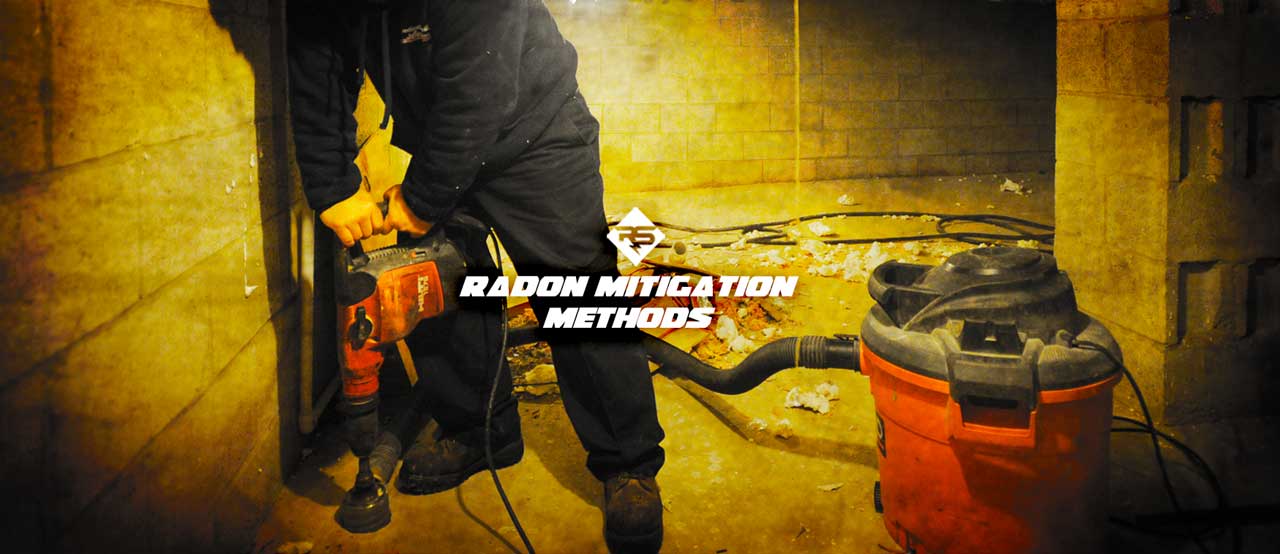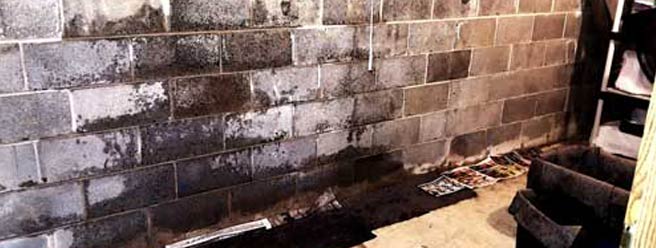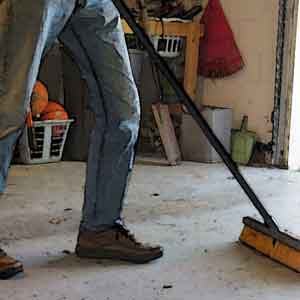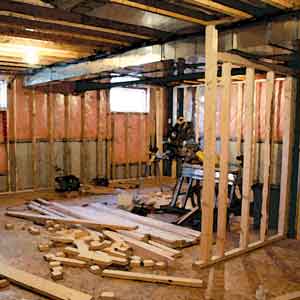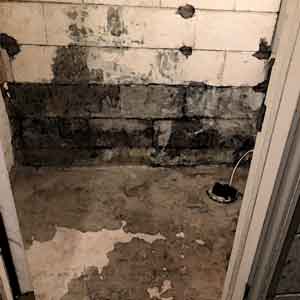How to Reduce Radon in Your Home
There is no “safe level” of this radioactive gas in homes and homeowners should always strive to reduce its concentration to a minimum. The US EPA recommends that you should mitigate if your radon test reads 4 pCi/L or higher, and consider radon mitigation if the radon level is above 2 pCi/L.
How To Select The Best Radon Mitigation System
The operational costs of radon ventilators include energy losses in heated and air-conditioned air drawn from the basement which can be several times higher than the cost of electricity. There are five basic criteria for the optimum system:
- Lowest Radon Level Possible
- Installation Costs
- Operational Costs
- Noise Burden in Living Areas
- Appearance Impact on House
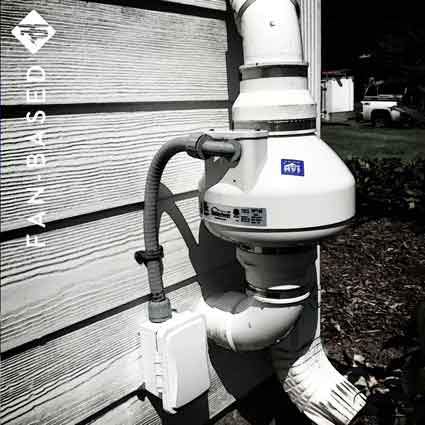
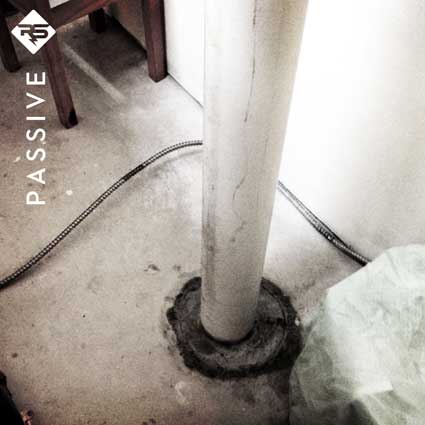
Types of Radon Reduction Methods
Here are a few radon reduction methods available to homeowners. For more about operating costs, view Operating Costs of ASD Radon Mitigation System.
Comparison of Radon Remediation Methods |
||||
|---|---|---|---|---|
| Method | Typical Radon Reduction | Typical Installation Costs | Typical Annual Operating Costs – Fan electricity and energy losses in heated/cooled air | Review |
| Fan-Based Subslab Suction (Active Subslab Depressurization) | 50%-99% | EPA: $800-2,500 |
$225-500 | Recommended by the US EPA. Works best if air can move easily under the slab in the un-silted gravel bed. |
| Passive Subslab Depressurization | 30% – 70% | $550-$2,2250 | Some Energy Losses | Recommended by the US EPA for new construction. Depends on weather. A fan can be easily added. |
| Draintile Suction | 50%-99% | $800-1,700 | $50-200 | Works best if drain tiles form a complete loop around the basement. |
| Sump Hole Suction | 50%-99% | $800-2,500 | $50-250 | Works best if air can move easily under the slab to the sump and if drain tiles form a complete loop. |
| Blockwall Suction | 50%-99% | $1,500-3,000 | $150-400 | Only for basements with hollow block walls; requires sealing of all openings. |
| Caulking | 0%-40% | $100-600 | $0 | Blocking of radon through voids. Ignores radon infiltration through concrete. Used in combination with other methods. |
| Basement Pressurization with Fan | 50%-90% | $500-1,500 | $150-500 | Requires tight basements that can be isolated from outdoors and upper floors. Reduces convection but not radon diffusion – the main factor. |
| Natural Ventilation | Variable | $200-500 if additional vents are installed | $200-700 | High loss in heated or conditioned air; operating costs depend on the ventilation and utility rates. Unpredictable results. |
| Basement Ventilation Fan with Heat Recovery | 25%-50% if used for full house; 25%-75% if used for the basement | $1,200-2,500 | $75-500 for continuous operation | Reduces energy losses in heated/conditioned air. Works best in a tight house. May cause back-drafting. |
| Seal Concrete & Repair Voids/Cracks | 70%-95% | $400-$700 | $0 | Sealing porous concrete. Sealing Easy Pathways/Voids in Basement. Used in combination with other methods. |
Radon Mitigation In Two Basic Steps
DIY Method – Simple DIY methods could go a long way. If your basement is unfinished and unpainted, now would be the time that you can help reduce radon levels with two simple steps. The same method applies to buildings with foundation slabs and to houses with crawlspaces, when installing a fan-suction system may not be feasible.
- Seal the Paths of Least Resistance
- Seal the Concrete
Step 1 – Radon easily flows through openings, voids, holes, joints, and cracks in the basement. As required by all mitigation methods, seal or caulk (polyurethane) all such openings airtight. For permanent solutions, please review our line of crack and joint repair kits:
- DIY Foundation Wall Crack Repair Kits
- CrackWeld Concrete Floor Crack Repair Kit
- ElastiPoxy Joint & Crack Repair Kit
Step 2 – Concrete is porous. Seal basement and crawlspace concrete walls and floors with RadonSeal Deep-Penetrating Concrete Sealer. RadonSeal will both strengthen and densify the concrete and help restrict water vapor, moisture, and radon gas through the concrete’s microscopic pores. If you have a slab-on-grade home and have the opportunity to apply a sealer, seal the floor before installing flooring, carpeting, or concrete levelers.
Advantages of Using RadonSeal Products
Sealing concrete and repairing voids and cracks can potentially save the average homeowner $4,250 on installation and operation costs over a ten-year period. According to the EPA, manufacturer warranties for fans do not exceed five years and you will eventually need to have it replaced by a radon mitigation contractor. Learn How To Save $1,000’s on Radon Mitigation.
Using RadonSeal Concrete Sealer our Crack Repair Kits can make radon mitigation affordable. There are no operating costs or energy losses in heated or air-conditioned air. No annoying hum of a radon fan on balmy summer nights. In many cases, homeowners have been able to reduce radon levels below the EPA Action Limit of 4 pCi/L. There is no denying that the mitigation of radon in homes can be a tricky endeavor, even for the most experienced contractor. Similar to waterproofing, each home and situation is unique. If you have detailed questions about your radon mitigation project please contact a RadonSeal Customer Service Representative for expert advice.
Add RadonSeal with Fan-Based Systems
Go The Distance – If you already have a mechanical radon mitigation system or plan on installing one, sealing the concrete with RadonSeal will reduce the radon level further. In addition, it will decrease the energy loss in conditioned indoor air drawn through the concrete floor to the fan. Sealing the concrete is not subject to mechanical breakdowns and will act as a backup system for power outages and fan failures.
Weather Plays a Role – If you have a passive sub-slab depressurization system, the radon level often depends on the weather, like temperatures and wind speed. Play it safe and seal your concrete.
The added benefit to sealing concrete is that RadonSeal will help improve the indoor air quality of your basement. It will greatly restrict the infiltration of water vapor and moisture through the concrete which in turn, helps alleviate condensation and humidity. Reduce moisture, you will reduce musty odors due to mold spores. Dusty concrete? RadonSeal is a strengthener and will harden the surface against surface wear and deterioration.
Finished or Painted Basements
Call a Radon Specialist – Getting fan-suction radon mitigation installed is the only practical solution for fully finished basements. Google search for a properly certified radon mitigation contractor in your area.
Painted Walls – Sealing only the floor with RadonSeal can help. Much more radon tends to penetrate through the slab than through the walls because radon gas is trapped underneath between the footings. Soil gas outside the basement walls can easily escape upwards to the atmosphere.
Covered Floor – Some homeowners have been successful by lifting the carpet or linoleum and sealing just the floor. However, if the basement floor is painted, covered with floor tiles, or adhesive removal is a tedious job. Best to call a specialist.
Basement Bathroom – Gravel-filled, rectangular openings around plumbing and under bathroom tubs is a major pathway that easily allows radon to escape into homes. Call a specialist for mitigation solutions.
The added benefit to sealing concrete is that RadonSeal will help improve the indoor air quality of your basement. It will greatly restrict the infiltration of water vapor and moisture through the concrete which in turn, helps alleviate condensation and humidity. Reduce moisture, you will reduce musty odors due to mold spores. Dusty concrete? RadonSeal is a strengthener and will harden the surface against surface wear and deterioration.
Appearance of Your House
According to the Consumer’s Guide from the EPA:
“Minimize the effect of installing a radon reduction system in your house by assuring that it blends with its surroundings. For instance: radon vent pipes may be encased with materials that match the exterior of your house, or the pipes may be routed indoors up through closets. Suction systems require that one or more holes be drilled through the basement floor, preferably in a central location. The piping will likely constrain your ideas on finishing the basement.”
Protect the Market Value of Your Home – Radon fans and piping tends to raise some concern for potential home buyers, who may have never heard that there is a radioactive gas called radon. Real estate agents agree that fan mitigation systems reduce the market value of homes. RadonSeal Concrete Sealer and Crack Repair Kits help eliminate the issues of unsightly piping and lost indoor space.
Back Drafting & Fan-Suction Systems
Radon mitigation fans draw not just soil gas from the ground but also indoor air from the house through the concrete slab. This may cause back drafting and spillage of combustion gases from the furnace, water heater, or fireplace in modern, tight houses. Installing a CO alarm with fan-based radon mitigation is a good idea! Lung cancer may kill someone in 20 years, but carbon monoxide can kill them in 20 minutes!
The risk of back drafting increases as energy-efficient houses are getting more and more air-tight. Houses are already depressurized due to the natural “stack effect” and appliances vented to the atmosphere, like combustion appliances, fireplaces, exhaust fans in the bathrooms and kitchen (may exhaust 750 cfm of air), clothes dryers, range hoods, etc. The radon mitigation fan flow of say, 100 cfm is comparable to a clothes dryer. In a leaky house, this might reduce the indoor air pressure by only 1 Pa but in a tight house, it may produce depressurization of 5–10 Pa which will reverse chimney flows. If the house is already depressurized at say 4 Pa, adding a fan-based radon mitigation system may take it over the backflow limit of 5 Pa.
Building codes recommend that each appliance should provide its own make-up air. However, they rely on passive openings, and dependent on wind direction, they may actually draw more air from the house. Spillage-resistant appliances (e.g. direct vent gas appliances) are a much more reliable solution.
Avoid Re-Entrainment of Radon Gas
According to the EPA:
“When radon is vented from the radon mitigation system it tends to sink and there is a danger of radon re-entering the building through doors and windows due to the vacuum (“stack”) effect. To prevent re-entrainment of radon, the point of discharge from vents of fan-powered soil suction and block wall suction systems must meet all of the following requirements: (1) be above the eave of the roof, (2) be ten feet or more above ground level, (3) be ten feet or more from any window, door, or other opening, and (4) be ten feet or more from any opening into an adjacent building. The exhaust point should be positioned above the highest eave of the building and as close to the roof ridge line as possible.”
RadonSeal Concrete Sealer and sealing openings avoids the danger of radon re-entrainment by leaving the radioactive gas where it belongs, in the ground. Moreover, RadonSeal does not create an invisible cloud of radioactive gas which, being eight times heavier than air, tends to settle and deposit radioactive particles in the immediate surroundings of the house.
Other Radon Remediation Ideas
Some people believe that paints and surface sealers, particularly epoxy or rubber-based, will stop radon. However, a layer of paint or even a polyethylene sheet has no chance of stopping radon atoms. Moreover, alkalis carried by moisture from inside the concrete attack paints and cause their cracking and peeling. During the time when the US EPA was testing paints and surface sealers, their conclusion was that they are not effective.
Sheetrock, wallpaper, plaster, or even polyethylene sheets do not stop radon. Covering floors with carpeting or linoleum does not work either. Remember that even several inches of concrete cannot stop radon.
Some builders believe that the plastic vapor barrier under the slab will stop radon. Although it is a part of the “radon-resistant” construction, it merely reduces the flow of soil gas. However, it cannot stop the diffusion of radon and its accumulation underneath the floor. That’s why EPA properly calls it the “soil gas retardant” membrane.
